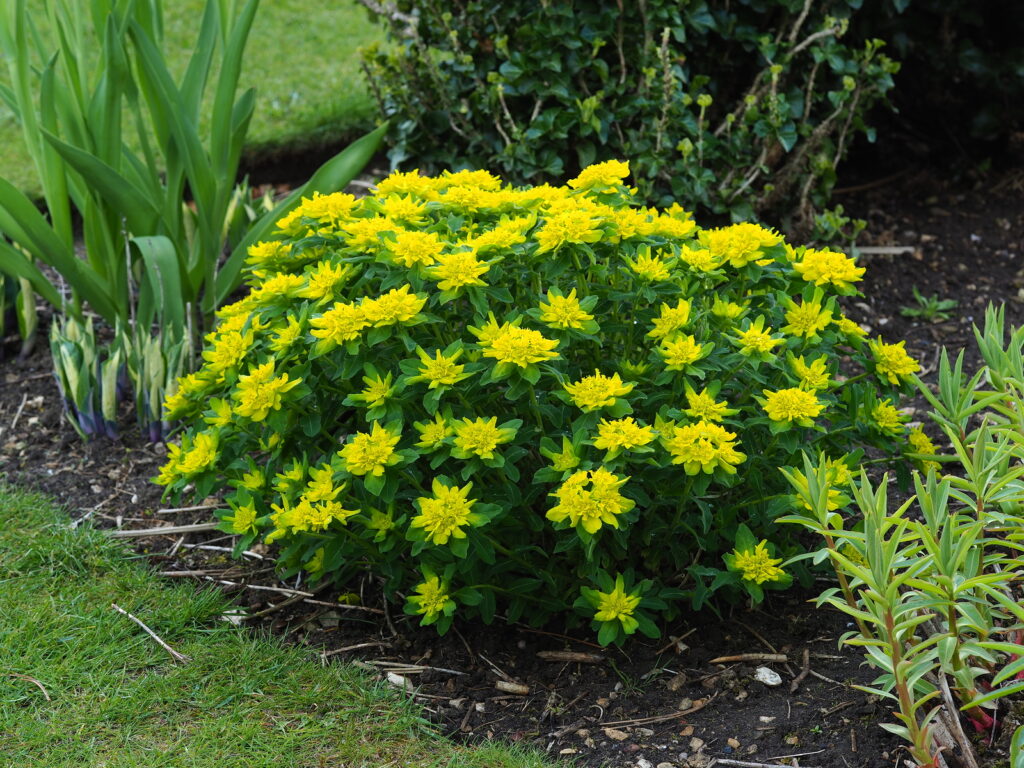Cushion spurge – botanical name Euphorbia epitbymoides – creates symmetrical dense mounds of pale green leaves topped with chartreuse flowerlike bracts. Cushion spurge brings a splash of bright color to the garden from spring well into summer. Foliage turns deep red foliage in autumn. Cushion spurge is one of the longest lived and easiest-to-care-for perennials.
Cushion spurge is a perennial that forms mounds of small green leaves on upright stems. Cushion spurge is best planted in groups and at the front of beds.
Get to know Cushion Spurge – Euphorbia
- Plant type: Perennial
- Growing Zones and range: 4-8
- Hardiness: Hardy
- Height and width: 12”- 18” tall; 12”- 18” wide
- Flowers: Bright yellow flowers surround chartreuse bracts; foliage turns shades of purple, red, yellow, and orange in fall
- Bloom time: Mid-spring
- Light: Full sun in the North; afternoon shade in the South.
- Uses: Place at the front of borders or use as edging plant; grows well in containers; combine with spring-blooming bulbs, hardy geraniums, and blue plumbago
- Botanical name: Euphorbia polychrome (Euphorbia epithymoides)
- Common name: Cushion Spurge
Where to plant Cushion Spurge – Euphorbia
- Plant cushion spurge in full sun in Zones 4-6 and Pacific Northwest; plant in shade in Zones 7-8.
- Grow plant spurge in sandy, well-drained soil.

When to plant Cushion Spurge – Euphorbia
- Set out established plants in spring or fall.
Planting and spacing Cushion Spurge – Euphorbia
- Space cushion spurge 12 to 18 inches apart.
How to water and feed Cushion Spurge – Euphorbia
- Give cushion spurge moderate water; established plants can tolerate drought.
- Fertilize cushion spurge occasionally.
Cushion Spurge – Euphorbia care
- Mulch around cushion spurge to conserve soil moisture.
- Cushion spurge can become invasive in moist soil.
- Divide cushion spurge when plants become floppy, every few years.
- Cushion spurge is commonly pest and disease-free.
- Plant sap may cause rash. May be invasive in moist soil.
Cushion Spurge – Euphorbia propagation
- Plant container-grown plants in spring, spacing 2 feet apart. Take cuttings after flowering, removing flowering tips. Divide only when mature plants become leggy or floppy.
Euphorbia epitbymoides similar species
- Euphorbia palustris, 3 feet tall, yellow-green bracts.
- E. myrsinites resembles a succulent with silvery gray leaves arranged spirally around creeping stems, yellow bracts. Zones 5-9.
Garden Spurge – Euphorbia garden use
- Use Cushion Spurge Euphorbia epitbymoides in foreground of formal beds and borders.















